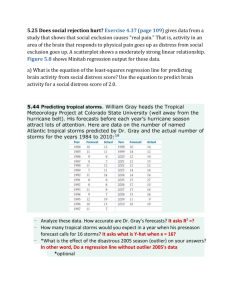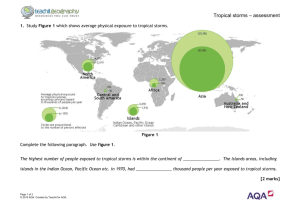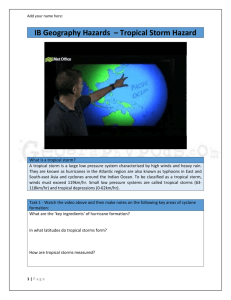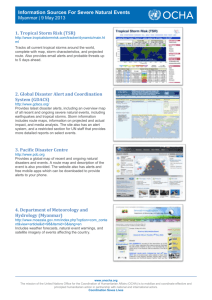the adaptable Word resource
advertisement
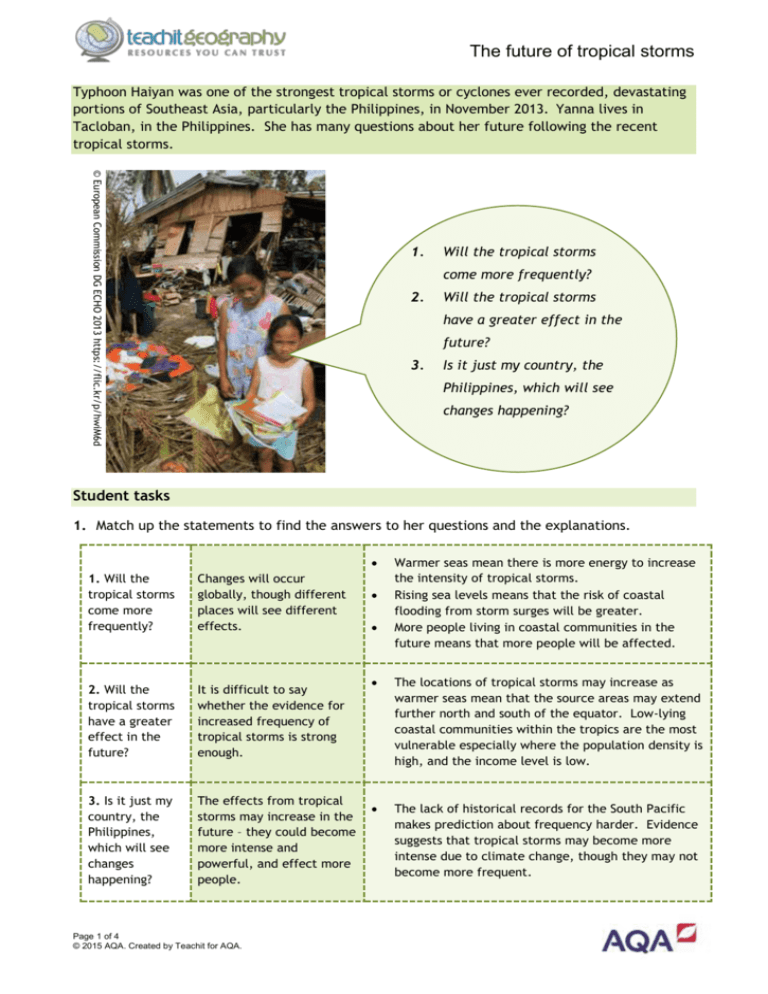
The future of tropical storms Typhoon Haiyan was one of the strongest tropical storms or cyclones ever recorded, devastating portions of Southeast Asia, particularly the Philippines, in November 2013. Yanna lives in Tacloban, in the Philippines. She has many questions about her future following the recent tropical storms. © European Commission DG ECHO 2013 https://flic.kr/p/hwiM6d 1. Will the tropical storms come more frequently? 2. Will the tropical storms have a greater effect in the future? 3. Is it just my country, the Philippines, which will see changes happening? Student tasks 1. Match up the statements to find the answers to her questions and the explanations. 1. Will the tropical storms come more frequently? Changes will occur globally, though different places will see different effects. 2. Will the tropical storms have a greater effect in the future? It is difficult to say whether the evidence for increased frequency of tropical storms is strong enough. 3. Is it just my country, the Philippines, which will see changes happening? The effects from tropical storms may increase in the future – they could become more intense and powerful, and effect more people. Page 1 of 4 © 2015 AQA. Created by Teachit for AQA. Warmer seas mean there is more energy to increase the intensity of tropical storms. Rising sea levels means that the risk of coastal flooding from storm surges will be greater. More people living in coastal communities in the future means that more people will be affected. The locations of tropical storms may increase as warmer seas mean that the source areas may extend further north and south of the equator. Low-lying coastal communities within the tropics are the most vulnerable especially where the population density is high, and the income level is low. The lack of historical records for the South Pacific makes prediction about frequency harder. Evidence suggests that tropical storms may become more intense due to climate change, though they may not become more frequent. The future of tropical storms 2. Answer either part a, part b or part c. a. Use the information from the table to write a mini information leaflet for Yanna to give to her friends. The title is – Possible effects of climate change on tropical storms. The leaflet should include: basic effects of climate change on coastal areas, e.g. the increase in sea surface temperature and the increase in sea level the possible effects of climate change using the sub headings: frequency, distribution and intensity of future tropic storms. b. Using the word bank below, complete the writing frame to show the possible effects of climate change on tropical storms: Word bank low west south temperature frequent increase level size decrease less frequent warmer darker Possible effects of climate change on tropical storms Climate change does affect everyone. Climate change can cause an increase in sea ____________________ and an increase in the ______________________________ of the sea. Frequency: The evidence says that tropical storms may become more intense but not necessarily more __________________________. Distribution: Warmer seas mean that the source areas for tropical storms become further ________________ and South of the equator. Higher sea levels mean that more _____________ lying coastal communities will be affected. Intensity: _______________ seas mean more energy to _______________ the intensity of tropical storms. Page 2 of 4 © 2015 AQA. Created by Teachit for AQA. The future of tropical storms c. Complete the following sentences. Circle the correct answer in each set of brackets. Possible effects of climate change on tropical storms Climate change [does / does not] affect everyone. Climate change can cause [a decrease / an increase] in sea levels and an increase in the [colour/level] of the sea. The evidence says that tropical storms may become more intense but not necessarily more [frequent/infrequent]. Warmer seas mean that the source areas for tropical storms become further [north/west] and south of the equator. Higher sea levels mean that [highland / more low-lying] coastal communities will be affected. 3. Tick the correct box to show whether each of the following statements is true or false. True False Typhoon Haiyan was one of the strongest tropical cyclones ever recorded Climate change will mean more intense and more frequent tropical storms in the future. Future tropical storms will only affect the Philippines. Extension task In March 2015, Tropical Cyclone Pam devastated the small country of Vanuatu and the government requested US$ 29.9 million in aid from the international community. Vanuatu’s President Baldwin Lonsdale blamed the disaster partly on climate change. Write a letter from the president to the United Nations explaining why he believes that climate change is partly responsible for the devastation. Page 3 of 4 © 2015 AQA. Created by Teachit for AQA. The future of tropical storms Teaching notes – suggested answer 1. Will the tropical storms come more frequently? The lack of historical records for the It is difficult to say whether the South Pacific makes prediction about evidence for increased frequency harder. Evidence suggests frequency of tropical storms is that tropical storms may become more strong enough. intense due to climate change, though they may not become more frequent. 2. Will the tropical storms have a greater effect in the future? 3. Is it just my country, the Philippines, which will see changes happening? The effects from tropical storms may increase in the future – they could become more intense and powerful, and effect more people. Changes will occur globally, though different places will see different effects. Warmer seas mean there is more energy to increase the intensity of tropical storms. Rising sea levels means that the risk of coastal flooding from storm surges will be greater. More people living in coastal communities in the future means that more people will be affected. The locations of tropical storms may increase as warmer seas mean that the source areas may extend further north and south of the equator. Low-lying coastal communities within the tropics are the most vulnerable especially where the population density is high, and the income level is low. True Typhoon Haiyan was one of the strongest tropical cyclones ever recorded False True Climate change will mean more intense and more frequent tropical storms in the future. False Future tropical storms will only affect the Philippines. False Page 4 of 4 © 2015 AQA. Created by Teachit for AQA.
